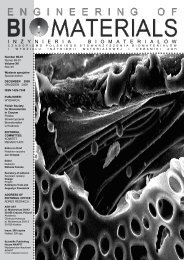62 - Polskie Stowarzyszenie BiomateriaÅów
62 - Polskie Stowarzyszenie BiomateriaÅów
62 - Polskie Stowarzyszenie BiomateriaÅów
Create successful ePaper yourself
Turn your PDF publications into a flip-book with our unique Google optimized e-Paper software.
Podsumowując można stwierdzić, że odpowiedni dobór<br />
techniki i czasu modyfi kacji może poprawić właściwości<br />
biologiczne materiałów resorbowalnych, przeznaczonych<br />
dla inżynierii tkankowej kości.<br />
Podziękowania<br />
Autorzy dziękują Pani Dr C. Paluszkiewicz za pomoc w<br />
badaniach FTIR-ATR. Praca była fi nansowana z projektu<br />
badawczego 3 T 08D 019 28.<br />
Conclusion<br />
In order to gain optimal biological properties<br />
of poly(glycolide-co-L-lactide) for osteoblasts culturing its<br />
surface was modifi ed in the liquid oxidizer. It was found<br />
that 0.1M NaOH etched PGLA surface, what resulted<br />
in topographical changes, increase in roughness, but without<br />
alteration of chemical structure, wettability and molecular<br />
mass. In vitro studies show that the best growth of osteoblast-like<br />
cells was observed on PGLA modifi ed for 6h, i.e.<br />
on the material having the roughness of ~60 nm. Interestingly,<br />
on PGLA films with lower or higher roughness, the cell<br />
adhesion and proliferation were considerably worse.<br />
To sum up, a choice of an adequate technique and modification<br />
conditions can improve biological properties of resorbable<br />
polymers intended for bone tissue engineering.<br />
Acknowledgements<br />
The authors thank Dr. C. Paluszkiewicz for her help in<br />
FTIR-ATR studies. This study was fi nanced from the research<br />
project No 3T08D 019 28.<br />
17<br />
Piśmiennictwo<br />
[1] B.L.Seal, T.C. Otero, A.Panitch. Polymeric biomaterials for tissue<br />
and organ regeneration. Materials Science and Engineering R4<br />
(2001) 147-230.<br />
[2] E. Pamuła, V. De Cupere, Y.F. Dufrene, P.G. Rouxhet. Nanoscale<br />
organization of adsorbed collagen: Infl uence of substrate<br />
hydrophobicity and adsorption time, Journal of Colloid Interface<br />
Science 271 (2004) 80-91.<br />
[3] H. Kaczmarek, J. Kowalonek, A. Szalla, A. Sionkowska. Surface<br />
modifi cation of thin polymeric fi lms by air-plasma or UV-irradiation.<br />
Surface Science 507-510 (2002) 883-888.<br />
[4] H. Tsuji, H. Satoh, S. Ikeda, S. Ikemura, Y. Gotoh, J. Ishikawa.<br />
Negative-ion beam surface modification of tissue-culture polystyrene<br />
dishes for changing hydrophilic and cell-attachment properties,<br />
NIM b 148 (1999) 134-1140.<br />
[5] G.E. Park, A. Pattison, K. Park, T.J. Webster. Accelerated chondrocyte<br />
functions on NaOH-treated PLGA scaffolds. Biomaterials<br />
26 (2005) 3075-3082.<br />
References<br />
[6] R.J. Vance, D.C. Miller, A.Thapa, K.M. Haberstroh, T.J. Webster.<br />
Decreased fi broblast cell density on chemically degraded<br />
poly-lactic-co-glicolic acid, polyurethane, and polycaprolactone.<br />
Biomaterials 25 (2004) 2095-2103.<br />
[7] Yun-Qi Wang, Ji-Ye Cai. Enhanced cell affi nity of poly(L-lactic<br />
acid) modifi ed by base hydrolysis: Wettability and surface roughness<br />
at nanometer scale. Current Applied Physics 7S1 (2007)<br />
108-111.<br />
[8] P. Dobrzyński, J. Kasperczyk, H. Jeneczek, M. Bero.: Synthesis<br />
of biodegradable copolymers with the use of low toxic zirconium<br />
compounds. 1. Copolymerisation of glycolide with L-lactide initiated<br />
by Zr(acac) 4 . Macromolecules 34, (2001), 5090-5098.<br />
[9] E. Pamuła, M. Błażewicz, C. Paluszkiewicz, P. Dobrzyński: FTIR<br />
study of degradation products of aliphatic polyesters–carbon fibres<br />
composites. Journal of Molecular Structure 596 (2001) 69-75.













